Costa Group to start deploying Arugga’s pollination robots across Australian tomato fields
The Israeli startup aims to help growers solve critical challenges related to more efficient pollination and reduced labor costs, while reducing the spread of viruses with its non-contact solutions
Costa’s tomatoes are grown in one of Australia’s largest and most advanced glasshouse facilities in the New South Wales town of Guyra. In total, Costa’s current Guyra glasshouses have 302,400 square meters of growing area, and during peak production contain more than one million plants. The company is in the process of increasing its production area by 33% to 40%.
 Arugga's robots provide a contactless solution for treating tomato plants (illustrative). Photo: Shutterstock
Arugga's robots provide a contactless solution for treating tomato plants (illustrative). Photo: Shutterstock
Founded in 2017, Arugga develops robotic solutions to treat and monitor individual plants in greenhouses. The company has focused its early product development on robotic pollination to replace manual methods and bumblebees. It is a portfolio company of the Smart Agro R&D partnership.
According to Dganit Vered, Smart Agro CEO, "the Israeli agro-tech industry is experiencing significant momentum, alongside the growth in the world’s population, and taking into account the shortage in resources like water, land, and bees. The continuous war against plant diseases requires creative technological solutions. I believe that the introduction of innovative technologies like Arugga’s will provide a real solution for the existing problems in the global market of greenhouse agriculture,” she said.
“We are grateful to the Costa Group for being an early believer in our technology. We have managed to overcome Covid-related barriers, successfully completing a trial remotely from Israel,” noted Arugga CEO Iddo Geltner. “We look forward to expanding our collaboration with Costa, with initial coverage of their vine tomato crops.”
 Arugga's robot. Photo: Arugga
Arugga's robot. Photo: Arugga
Beyond pollination, the Arugga team has started working on a second module which will be added to the same robotic platform and also supports pollination. Geltner commented that his company aims to be the “boots on the ground,” and help other growers solve critical challenges related to more efficient pollination and reduced labor costs, while reducing the spread of viruses with its non-contact solutions.



